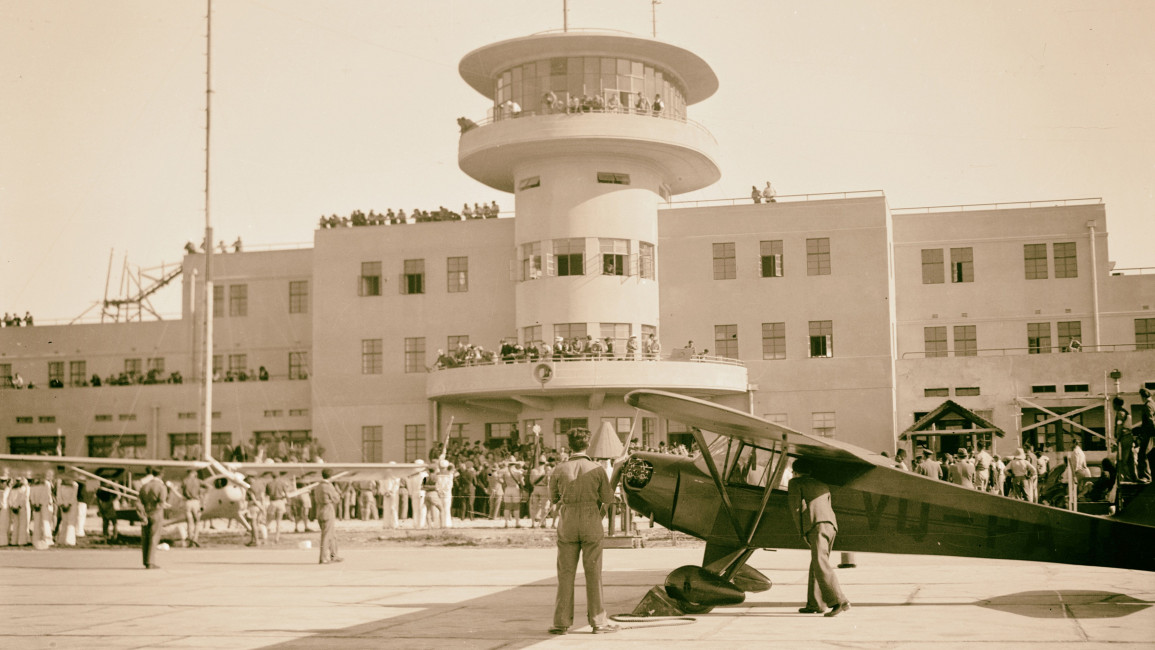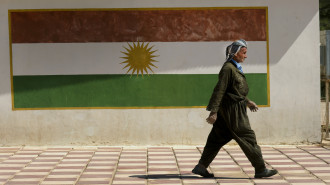

Israel's KAN public broadcaster reported last week that Israeli authorities were considering opening the Ramon Airport in the Negev, 137 miles south of Gaza, for Palestinian travellers.
Implementing the plan would be preconditioned on “political calm” and the Palestinian Authority’s withdrawal of lawsuits against Israel at the ICC.
Israel will accordingly provide a “safe passage” and flights for West Bank Palestinians from the airport; as such, they will not need to cross into Jordan to fly overseas. An initial route will be established between Ramon and Istanbul for that purpose.
The Palestinian Authority was quick to rebuff Israel’s plan as a “unilateral act” that emphasises racial segregation, and demanded that Israel reopen Qalandiya Airport, otherwise known as ‘Jerusalem Airport’.
"Before the partition of Palestine in 1947 and the Nakba, the British mandate authorities saw Palestine as a hub for commercial and military routes and, as such, invested in building infrastructure to fulfil that vision"
Palestinians build on the fact that Qalandiya Airport, located within the 1967 borders, is historically Palestinian. At the Camp David summit in 2000, the Palestinian envoy rejected Israeli maps that included the airport within the boundaries of the Jerusalem Municipality.
The issue was also brought up last year when former Israeli PM Benjamin Netanyahu’s Regional Cooperation Minister Issawi Freij proposed reopening the defunct airport, which Israel renamed ‘Atarot’, to be shared by Israel and the Palestinian Authority.
It remains unclear whether it was a personal or a government-prompted proposal, especially as it came shortly after Netanyahu advanced plans to build 9,000 settlement units in the region.
The airport lies along the road between Jerusalem and Ramallah, 5km from Ramallah and 10km from Jerusalem. It was opened in 1924 and served as a British army military base known as ‘Kolundia Airfield’.
With Israel’s establishment in 1948, the airport came under Jordanian supervision, along with the rest of the Palestinian West Bank. Jordan in the early 1950s turned it into a civil airport and named it the Jerusalem Airport. Israel took control of it in 1967 and used it intermittently for domestic flights until 2000.
The once bustling airport is today a derelict site devoid of planes, flight attendants, or passengers. Its infrastructure has been largely reclaimed by nature.
Israel’s segregation wall now lies a short distance away, and on the route to the defunct airport sits the Qalandiya checkpoint, the main Israeli entry point between Jerusalem and the West Bank.
|
|
Freedom of movement
The debate over Ramon Airport coincided with almost unprecedented congestion at the Allenby Bridge border crossing between the occupied West Bank and Jordan. Severe overcrowding at the border resulted in Palestinians waiting for days to be allowed entry into the West Bank.
The Palestinian Authority and Jordan blamed Israel for placing a cap on the number of passengers who can enter daily, as opposed to the average of 7,000-15,000 passengers before the allegedly new Israeli measures.
A week before, a similar situation occurred at the notoriously restricted Rafah Crossing between Gaza and Egypt. Thousands of Palestinians were stranded for days on the Egyptian side in the summer heat as they waited their turn to enter Gaza.
In addition to the poor treatment and financial exploitation of Gazans by the Egyptian Authorities, the crossing has a very limited daily quota of passengers, made worse by the limited working hours, high fees, and the dangerous situation in Sinai.
"No feature of Israel's occupation is as pronounced and comprehensively restrictive to Palestinians' daily existence as the control over their freedom of movement"
All considered, for Palestinians, the Ramon versus Qalandiya discussion far exceeds the question of logistics; rather, it highlights the severe restrictions imposed by Israel on Palestinian freedom of movement.
No feature of Israel’s occupation is as pronounced and comprehensively restrictive to Palestinians’ daily existence as the control over their freedom of movement. Internal travelling is hindered by checkpoints, roadblocks, curfews, and closures. There are approximately 700 road obstacles across the West Bank, including 140 checkpoints.
Travel between the West Bank and Gaza is highly restricted and only allowed on exceptional humanitarian bases, not including marriage or family reunions.
Overseas travel is governed by similar measures but with the added disadvantage of thorough security screening and additional restrictions and mistreatment not only by Israel but also by Jordan at the Allenby Bridge, and Egypt at the Rafah Crossing.
For security reasons, Palestinians, including those with dual citizenship, are not allowed to use Israel’s Ben-Gurion Airport without a special permit.
This is why the prospect of an airport serving the Palestinian population in the West Bank and Gaza could go a long way to reduce the multi-tiered restrictions and provide Palestinians with a semblance of normality and dignity, somewhat similar to other people across the globe.
None of that means that the concept of an airport is alien to Palestine. Qalandiya Airport was Palestine’s first airport, but not the only one.
"In the wake of Israel's 1948 creation, Zionist forces took over the British-built Lydda Airport and renamed it Lod Airport. It eventually became Tel Aviv's Ben-Gurion International Airport"
Losing Palestine, losing the air
Before the partition of Palestine in 1947 and the ensuing Nakba, the British mandate authorities saw Palestine as a hub for commercial and military routes and, as such, invested in building infrastructure to fulfil that vision.
An important project in addition to Qalandiya Airport was the construction of Lydda Airport in 1936. The chosen site for the airport was midway between Jerusalem and Jaffa, in proximity to Palestine Rail’s Lydda Junction, on the outside of the Palestinian Arab town of Lydda (al-Lidd in Arabic, Lod in Hebrew).
This is despite Zionist officials' appeals to the British authorities to grant Tel Aviv, then the hub of European Jewish immigrants into Palestine, its own airport. This was then understood - and later proven - as part of the Zionist movement’s effort to fortify its economic, military, and social independence in Palestine.
Lydda Airport was meant as a British hub for transcontinental air routes from the eastern Mediterranean to India, alongside Haifa seaport, which was developed as a British naval base and a strategic endpoint of the oil pipeline from Iraq.
In the wake of Israel’s 1948 creation, Zionist forces took over the airport and renamed it Lod Airport. It is currently the site of Tel Aviv’s Ben-Gurion International Airport, which stands on the ruins of the Palestinian community that Israel ethnically cleansed from the area.
|
|
Oslo and Gaza's shattered dream
Israel’s inception ushered in - albeit in stages - an end to Palestinian air services. Only in 1994 with the Oslo Accords did the notion of a Palestinian airport return to the political agenda.
On security grounds, a Palestinian Authority-administered airport in the 1967 occupied territories was a difficult concept for Israel to accept. The notion of sovereignty typically associated with airports, which Israel was - and continues to be - unwilling to grant Palestinians, made the negotiations even harder.
Only by restricting the airport location to the southern Gaza Strip, near the Egypt border, and accepting Israeli direct supervision over its operations, had Israel allowed the Palestinian Authority to construct the Gaza International Airport, later named the Yasser Arafat International Airport.
Every step was done in coordination with the Israelis. Agreeing on a name alone took three months.
Devoid of sovereignty, Palestinians saw the agreement as the only realistic accomplishment before signing a comprehensive peace agreement, as per the conviction at the time regarding the future trajectory of the Oslo peace process.
Construction commenced in 1996, despite Israel’s attempts to obstruct the flow of construction materials to the airport. The airport was inaugurated in late 1998, at an estimated cost of $75 million mostly covered by Japan, Saudi Arabia, and the European Union.
It had a single runway equipped to handle most airliners including Boeing 747, and up to 700,000 passengers annually.
Then-US President Bill Clinton and his wife Hilary attended the inauguration ceremony. They flew in by a presidential helicopter as Israel refused to allow Air Force One to land in Gaza, once again signalling Israel’s dilemma with allowing Palestinians any semblance of sovereignty.
The first aircraft ever, one labelled ‘Palestinian Airlines’, that landed on the tarmac was a scene so emotional that people flooded into the airport to salute the crew.
"Israel's creation ushered in - albeit in stages - an end to Palestinian air services. Only in 1994 with the Oslo Accords did the notion of a Palestinian airport return to the political agenda"
Palestinian pilot Captain Zeyad al-Bada who flew from Cairo to Gaza, without aerial maps or radars, became the icon of that historic moment as he waved a small Palestinian flag through the airplane window, while the crowds surrounded the airplane cheering and dancing.
Yet, that hopeful moment was short-lived. Less than two years later, with the eruption of the Second Intifada in late 2000, the airport ceased operations, soon followed by repetitive Israeli bombardment that initially damaged the tower and destroyed the runway.
Over the following years, the Israeli army continued to target the airport, typically as a response to Palestinian resistance, either through air bombardment or land invasions. By 2010, every structure in the airport had been turned into a pile of rubble, shattering any hope for the resumption of its operations, and acting as a visual reminder of Gaza’s shattered connection to the world.
What had remained of the airport was scavenged by the impoverished local population.
|
|
A hefty cost
In addition to the high cost to the average traveller, the absence of a Palestinian-run airport has also diminished Palestine's economic independence and the prospect of growth.
As per the Oslo agreement and the Paris Economic Protocol, Palestinian exports and imports are transferred through Israeli ports, which increases transportation and inspection fees, storage costs, and wait times.
It has also allowed Israel to restrict items deemed dual-use (civilian/military) and those that may compromise the competitiveness of Israeli products sold in the Palestinian market.
Above all, Israel collects Palestinian VAT and import taxes, which has given the Israeli government the power to withhold Palestinian funds as a means of political pressure.
The suggestion to allow Palestinians to travel through Ramon Airport could substantiate economic dependency and further tighten Israel’s grip on Palestinian freedom of movement. Diverting Palestinians from Allenby Bridge to Ramon will contribute to Israel’s financial gains, considering that the airport has not seen international flights for over two years.
"In addition to the high cost to the average traveller, the absence of a Palestinian-run airport has also diminished Palestine's economic independence and the prospect of growth"
In the poverty-stricken Gaza Strip, suggestions were made by Israel, albeit not followed through, to build an artificial island off the Gaza coast and construct a seaport and an airport on it. The island will be connected to mainland Gaza by a 3-mile bridge.
Adding to its estimated $5 billion cost and ecological impact on Gaza’s already depleted sea life, this project will not be free from Israel’s monitoring, but will potentially spare Palestinians the Rafah Crossing’s mistreatment.
Neither Ramon Airport nor the suggested Gaza island will provide Palestinians with independence or sovereignty. Better humanitarian conditions, within Israel’s broad vision of “economic peace,” is the final goal, a situation that can rapidly change subject to any changes in the political atmosphere.
Dr Emad Moussa is a researcher and writer who specialises in the politics and political psychology of Palestine/Israel.
Follow him on Twitter: @emadmoussa






 Follow the Middle East's top stories in English at The New Arab on Google News
Follow the Middle East's top stories in English at The New Arab on Google News


